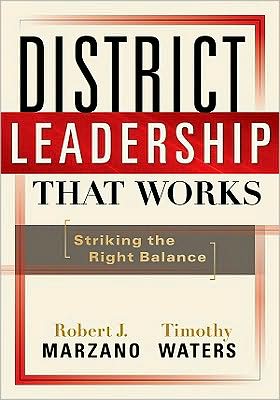District Leadership That Works: Striking the Right Balance
District leaders need not direct educational policy and progress from a distance. District Leadership That Works: Striking the Right Balance explores the research that proves district leadership does have an impact on student achievement in the classroom. When leaders strike the right balance between establishing overarching goals and supporting building-level autonomy on how to meet those goals, student achievement flourishes. The authors show how to strengthen and support the educational...
Search in google:
District leaders need not direct educational policy and progress from a distance. District Leadership That Works: Striking the Right Balance explores the research that proves district leadership does have an impact on student achievement in the classroom. When leaders strike the right balance between establishing overarching goals and supporting building-level autonomy on how to meet those goals, student achievement flourishes. The authors show how to strengthen and support the educational process through dynamic collaboration-with schools, teachers, boards, unions, and community members-that ensures every student's success.Readers gain insight into how to:Initiate second-order change to promote student achievementSet district-defined nonnegotiable goals for achievement and instruction at the district and school levels through a collaborative process with stakeholdersCreate defined autonomy that allows teachers creative freedom while ensuring learningMonitor goal progress through formative assessmentShift from past educational paradigms and respond to resistance to change
About the Authors ix1 Does District Leadership Matter? 1The Study 2The Relationship Between District Leadership and Student Achievement 4What Does a Correlation Tell You? 4Specific Leadership Behaviors 5Ensuring Collaborative Goal Setting 6Establishing Nonnegotiable Goals for Achievement and Instruction 6Creating Board Alignment With and Support of District Goals 7Monitoring Achievement and Instruction Goals 7Allocating Resources to Support the Goals for Instruction and Achievement 8A Surprising and Perplexing Finding: Defined Autonomy 8The "Bonus" Finding 9The District, Schools, and Teachers Working Together 9Summary 122 Putting Our Findings in Perspective 13Districts and Schools as Loosely Coupled Systems 13Issues With Site-Based Management 15The Call for Tight Coupling Regarding Achievement and Instruction 18The Evidence From High-Reliability Organizations 19The Evidence From Worldwide Study of Effective Schools 20A New View of District Leadership 21Summary 223 Setting and Monitoring Nonnegotiable Goals for Achievement 23The Context for Setting and Monitoring Nonnegotiable Goals for Achievement 24The Need for a Formatively Based, Value-Added System 27Characteristics of a Formatively Based, Value-Added System 29Phase 1 Reconstitute State Standards as Measurement Topics or Reporting Topics 30Monitoring Phase 1 36Phase 2 Track Student Progress on Measurement Topics Using Teacher-Designed and District-Designed Formative Assessment 39Monitoring Phase 2 42Phase 3 Provide Support for Individual Students 43Monitoring Phase 3 47Phase 4 Redesign Report Card 48Monitoring Phase 4 52Summary524 Setting and Monitoring Nonnegotiable Goals for Instruction 53Characteristics of High-Quality Teachers 54A Focus on Pedagogy 56Phase 1 Systematically Explore and Examine Instructional Strategies 57Monitoring Phase 1 59Phase 2 Design a Model or Language of Instruction 60Monitoring Phase 2 61Phase 3 Have Teachers Systematically Interact About the Model or Language of Instruction 62Monitoring Phase 3 63Phase 4 Have Teachers Observe Master Teachers (and Each Other) Using the Model of Instruction 63Monitoring Phase 4 65Phase 5 Monitor the Effectiveness of Individual Teaching Styles 65Monitoring Phase 5 69Summary 705 Collaborative Goal Setting, Board Alignment, and Allocation of Resources 71Collaborative Goal Setting 71Board Alignment and Support 75Allocation of Resources 77The United States Versus Other Countries 79Summary 856 Defined Autonomy in a High-Reliability District 87The Common Work of Schools Within a District 89School Leadership for Defined Autonomy 90District Initiative: Ensure Collaborative Goal Setting 94District Initiative: Establish Nonnegotiable Goals for Achievement and Instruction 96District Initiative: Create Board Alignment and Support 97District Initiative: Monitor Nonnegotiable Goals 98District Initiative: Allocate Resources 99Summary and Conclusions 1037 The Perils and Promises of Second-Order Change 105Living Through the Tough Times 107Some Advice for District Leaders 109Recommendation #1 Know the Implications of Your Initiatives 109Recommendation #2 Maintain a Unified Front 109Recommendation #3 Keep the Big Ideas in the Forefront 110Recommendation #4 Use What Is Know About Acceptance of New Ideas 110Recommendation #5 Communicate With "Sticky Messages" 111Recommendation #6 Manage Personal Transitions 112Revisiting the Bonus Finding 113Epilogue 115Technical Notes 117Technical Note 1.1 Interpretation of Correlation Between Principal Leadership and Student Achievement 117Technical Note 1.2 General Methodology Used in This Study 118Technical Note 1.3 Binomial Effect Size Display Interpretation of Correlations 126Technical Note 1.4 Correlation for Five District Responsibilities or Initiatives 129Technical Note 1.5 Correlation for Defined Autonomy 131Technical Note 1.6 Tenure 132Technical Note 1.7 District, School, and Teacher Effects 132Technical Note 3.1 Standardized Mean Difference Effect Size (ESd) 138Technical Note 3.2 Interpretation of Durlak and Weissberg (2007) Findings 139Appendix 141Reports Used in Meta-Analysis 141References 143Index 155







